[ad_1]
When creating decentralized purposes (dapps) and different Web3 platforms, you’ll shortly discover that you just want environment friendly methods of interacting and speaking with varied blockchain networks. A method of doing so is establishing blockchain listeners for monitoring related good contract occasions. Nevertheless, the million-dollar query is, how do you create blockchain listeners? A outstanding possibility is ethers.js, which is an Ethereum JavaScript library. If you wish to learn to use ethers.js to hearken to good contract occasions, be a part of us on this tutorial as we present you precisely how to take action!
Earlier than we present you tips on how to use ethers.js to hearken to occasions, let’s return to fundamentals and discover the weather of this library in additional element. From there, we’ll present a fast introduction to occasions on Ethereum – which we’re utilizing synonymously with “ethers.js occasions” – supplying you with a greater concept of what we wish to monitor. Upon getting familiarized your self with ethers.js and Ethereum occasions, we are going to present you tips on how to arrange a blockchain listener with ethers.js to watch on-chain occasions. Lastly, we are going to prime every thing off with a comparability between ethers.js and Moralis’ Web3 Streams API!
When you already know tips on how to arrange blockchain listeners with ethers.js, you must try extra Moralis content material right here on the Web3 weblog. As an example, try the last word Web3 py tutorial or study all you want in regards to the Sepolia testnet! What’s extra, earlier than shifting additional on this article, enroll with Moralis instantly! Creating an account is free, and as a member, you’ll be able to actually leverage the facility of blockchain expertise!
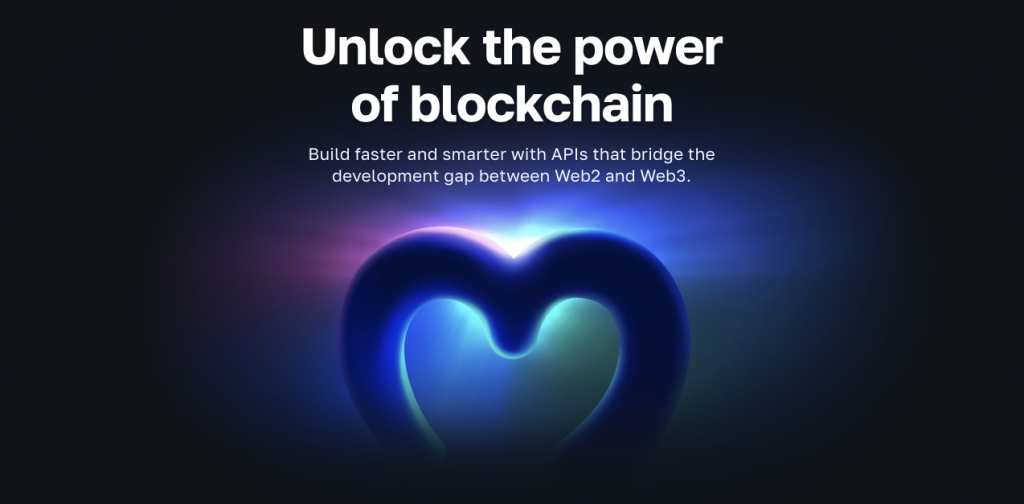
What’s Ethers.js?
Ethers.js is an Ethereum JavaScript (JS) library launched in 2016 by Richard Moore. It’s one among right now’s most well-used Web3 libraries, that includes thousands and thousands of downloads. Like conventional libraries, ethers.js additionally consists of a set of prewritten snippets of code used to carry out frequent programming duties. Nevertheless, a big distinction between standard libraries and ethers.js is that the latter is blockchain-based. Accordingly, this library makes it simpler for builders to work together with the Ethereum community.
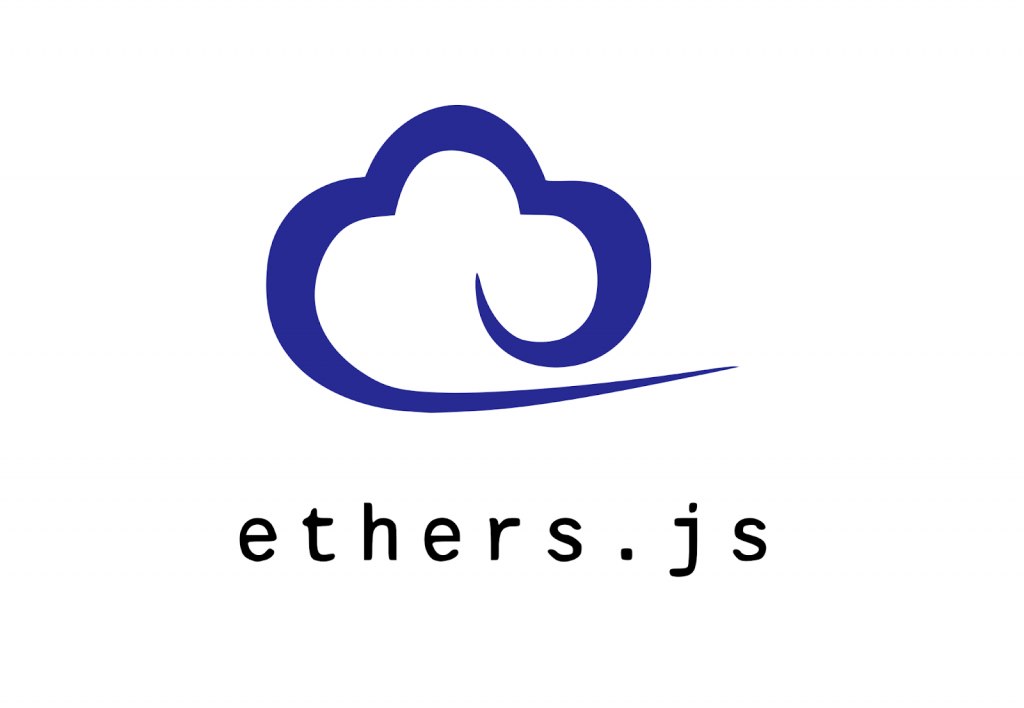
The library was initially designed to work with ”ethers.io”; nevertheless, since its launch, it has turn into a extra general-purpose library. Furthermore, ethers.js encompasses a user-friendly API construction and is written in TypeScript. Consequently, it is likely one of the prime decisions amongst rising Web3 builders, as ethers.js is simple and intuitive to make use of.
Nonetheless, to provide you a extra profound understanding of the library’s utility, allow us to briefly listing a number of the fundamental options of ethers.js:
ENS – Ethers.js helps Ethereum Title Service (ENS), which means ENS names are dealt with as first-class residents. Check Circumstances – The library options an in depth assortment of check instances, that are actively up to date and maintained. Dimension – Ethers.js is small, solely 284 KB uncompressed and 88 KB compressed.
Moreover, ethers.js has 4 core modules: “ethers.utils“, “ethers.wallets“, “ethers.supplier“, and “ethers.contract“. These 4 parts are important for the library’s utility programming interface (API). Nevertheless, if you wish to study extra about these, please try the next information answering the query, ”what’s ethers.js?” in additional element. You may also wish to think about testing extra Web3 libraries. In that case, learn our article on Web3.js vs ethers.js!
Occasions on Ethereum – What are Ethers.js Occasions?
Sensible contracts on the Ethereum blockchain networks usually emit varied occasions every time one thing occurs inside them primarily based on the code. What’s extra, these occasions are a type of sign emitted from contracts to inform dapps and builders that one thing of relevance has transpired. Accordingly, builders and platforms can use these indicators to speak.
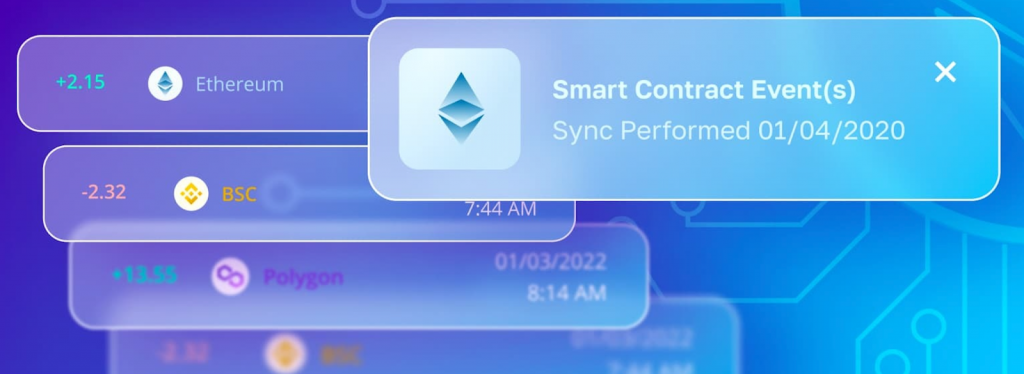
To make this definition extra simple, allow us to take a better take a look at the ERC-20 token customary for instance. All tokens implementing this good contract customary autonomously emit a ”switch” occasion every time they’re traded, and it’s attainable to arrange blockchain listeners monitoring these occasions. What’s extra, this is just one instance, and most good contracts emit occasions primarily based on different occurrences alike. Furthermore, these are the occasions that we’re moreover calling “ethers.js occasions”.
So, as you may need figured your self, you will need to have the ability to seamlessly hear to those ethers.js occasions in actual time. Additional, a technique of doing so is thru blockchain listeners. Nevertheless, how do you create one? If you’re on the lookout for the reply to this query, be a part of us within the subsequent part, the place we are going to present you tips on how to use ethers.js to hearken to blockchain occasions!
How Can Builders Use Ethers.js Occasions?
Now that you understand what ethers.js occasions are, the massive query is, how do you employ them? To adequately reply this query, the next part supplies an ethers.js instance the place we are going to present you tips on how to create a blockchain listener for monitoring the USD coin (USDC) good contract. Particularly, you’ll learn to monitor the good contract’s switch occasions.
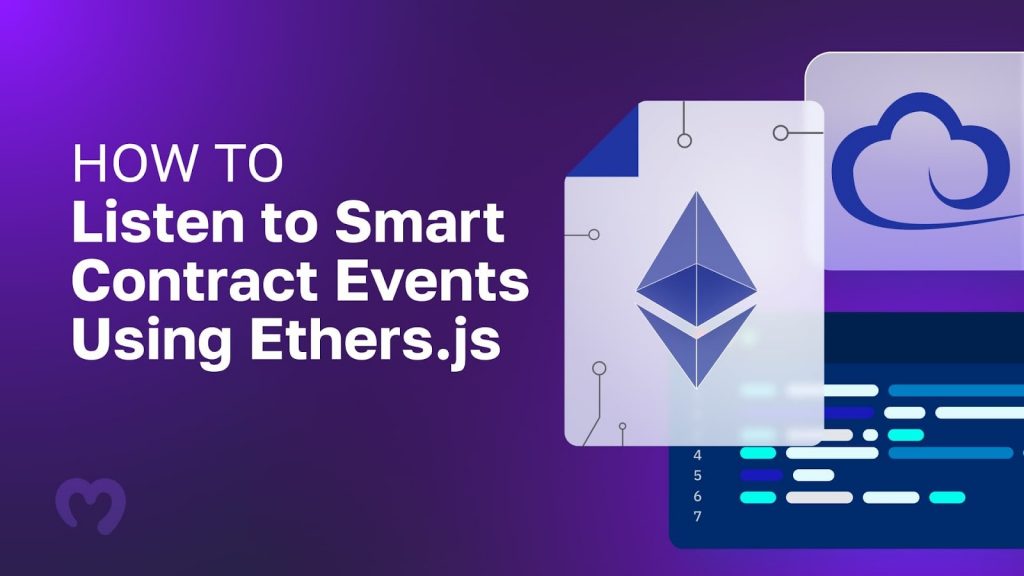
That mentioned – earlier than protecting the code for the blockchain listener – you will need to first arrange a NodeJS venture. From there, create two new recordsdata: ”.env” and ”abi.json”. Furthermore, it is advisable make the most of a node supplier when utilizing ethers.js to hearken to blockchain occasions. So, on this occasion, we will likely be utilizing Alchemy. Consequently, you will need to add your Alchemy key as an surroundings variable to the ”.env” file.
Subsequent, together with the supplier key, it is advisable add the USDC contract utility binary interface (ABI) to the ”abi.json” file. When you need assistance discovering the ABI of any Ethereum-based contracts, try Etherscan.
Lastly, to conclude the preliminary setup technique of the NodeJS venture, it is advisable set up a number of dependencies. As such, open a brand new terminal and run the next command:
npm i ethers dotenv
How you can Set Up an Ethers.js Blockchain Listener
Now that you’ve arrange the NodeJS venture, this part focuses on the ethers.js blockchain listener. As such, to proceed, create a brand new JavaScript file known as ”index.js”. Open the file and begin by including the next three strains of code on the prime:
const ethers = require(“ethers”);
const ABI = require(“./abi.json”);
require(“dotenv”).config();
The three strains from the code snippet above point out that ”index.js” makes use of the ethers.js library, together with importing the contract ABI and the surroundings variables from ”.env”. From there, the following step is including an asynchronous perform we’re going to name ”getTransfers()”:
async perform getTransfer(){
const usdcAddress = “0xA0b86991c6218b36c1d19D4a2e9Eb0cE3606eB48”; ///USDC Contract
const supplier = new ethers.suppliers.WebSocketProvider(
`wss://eth-mainnet.g.alchemy.com/v2/${course of.env.ALCHEMY_KEY}`
);
const contract = new ethers.Contract(usdcAddress, ABI, supplier);
contract.on(“Switch”, (from, to, worth, occasion)=>{
let transferEvent ={
from: from,
to: to,
worth: worth,
eventData: occasion,
}
console.log(JSON.stringify(transferEvent, null, 4))
})
}
This perform accommodates the logic for the ethers.js blockchain listener. Consequently, we are going to break down the code from prime to backside. Initially, on the primary two strains of the ”getTransfers()” perform, the code creates two variables: ”usdcAddress” and ”supplier”. For the primary one, you wish to specify the contract handle. For the latter, you will need to decide the node supplier utilizing your surroundings variable key.
Subsequent, the code creates a brand new ”contract” object by using the ”usdcAddress”, ”ABI”, and ”supplier” variables by passing them as arguments for the ”ethers.Contract()” perform. From there, the code units the listener utilizing the ”contract” object, specifying ”Switch” occasions as the subject of curiosity. Lastly, the code console logs the outcomes!
Nonetheless, the whole code of the ”index.js” file ought to now look one thing like this:
const ethers = require(“ethers”);
const ABI = require(“./abi.json”);
require(“dotenv”).config();
async perform getTransfer(){
const usdcAddress = “0xA0b86991c6218b36c1d19D4a2e9Eb0cE3606eB48”; ///USDC Contract
const supplier = new ethers.suppliers.WebSocketProvider(
`wss://eth-mainnet.g.alchemy.com/v2/${course of.env.ALCHEMY_KEY}`
);
const contract = new ethers.Contract(usdcAddress, ABI, supplier);
contract.on(“Switch”, (from, to, worth, occasion)=>{
let transferEvent ={
from: from,
to: to,
worth: worth,
eventData: occasion,
}
console.log(JSON.stringify(transferEvent, null, 4))
})
}
getTransfer()
How you can Run the Script
With all of the code added to the ”index.js” file, all that continues to be is working the script. To take action, open a brand new terminal and run the next command:
node index.js
When you execute the command above, the code will return USDC transactions knowledge in your console, and it’ll look one thing like this:
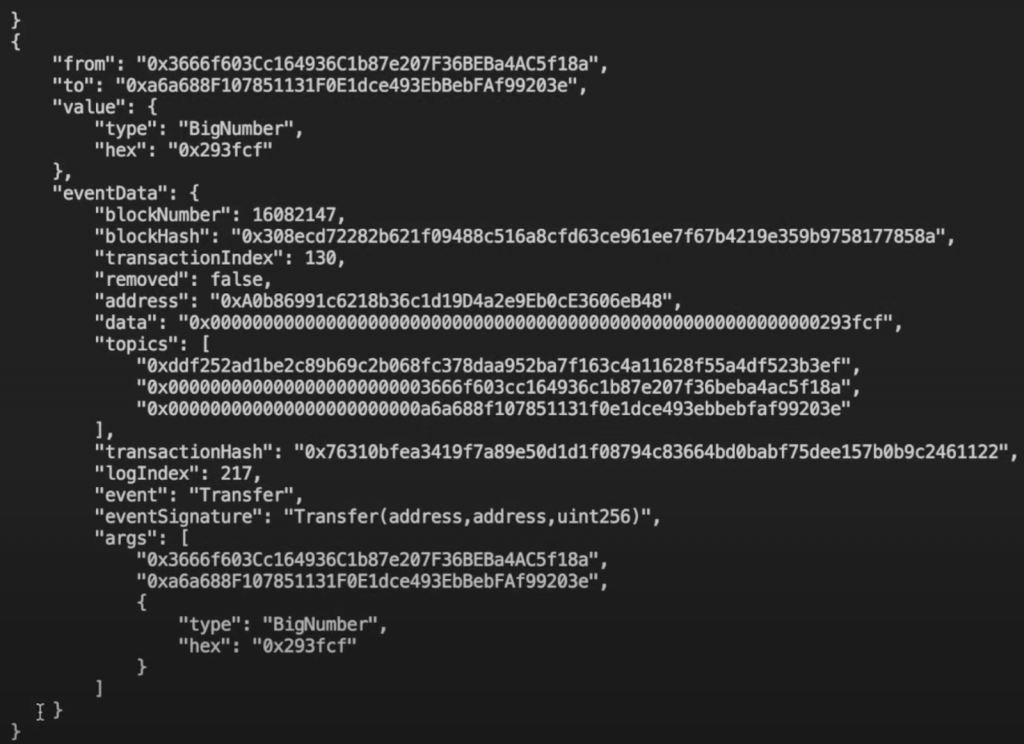
Operating the script returns an abundance of knowledge, together with the to and from addresses, occasion knowledge, and rather more. Sadly, the response above doesn’t include parsed knowledge, and we can’t, for example, decide the origin of the data. In conclusion, utilizing ethers.js for listening to blockchain occasions is a good begin, nevertheless it leaves extra to be desired. So, are there any ethers.js alternate options?
Is There an Various to Ethers.js Occasions?
Regardless that ethers.js is an effective possibility for establishing blockchain listeners for monitoring good contract occasions, it isn’t good. Consequently, it’s price contemplating different alternate options as properly. As an example, one of the vital outstanding examples is Moralis’ Streams API!
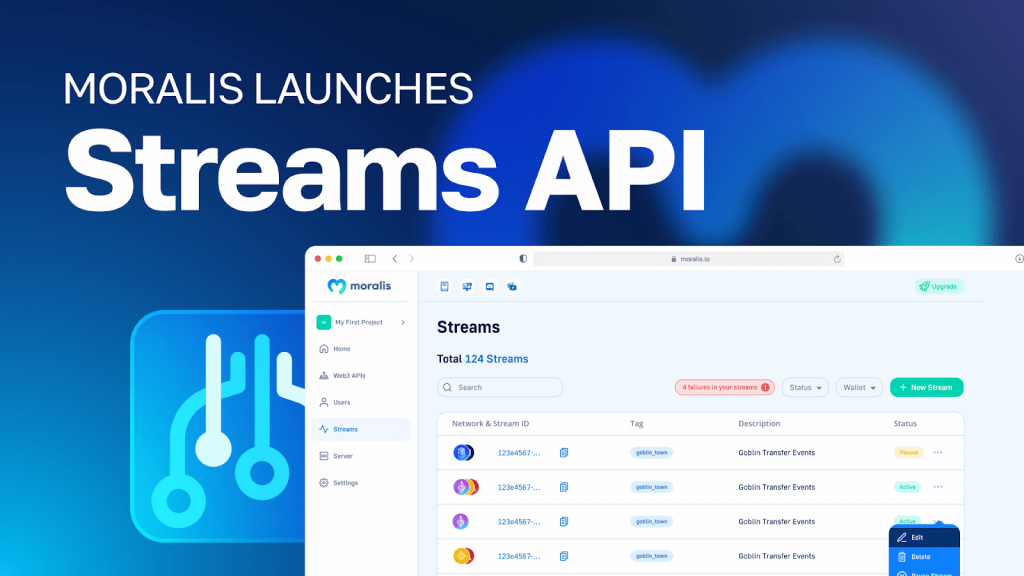
With the Streams API, you’ll be able to effortlessly stream on-chain knowledge into the backend of your blockchain initiatives by way of Web3 webhooks. By means of this Moralis characteristic, you’ll be able to arrange streams to obtain Moralis webhooks every time an handle receives, swaps, or stakes an asset, a battle begins in your blockchain sport, or another good contract occasions set off primarily based in your filters!
What’s extra, by way of the accessibility of Moralis, you’ll be able to arrange your personal streams in 5 simple steps:
Present a wise contract addressApply filters specifying when to obtain webhooksSelect the chain(s) you wish to monitorAdd your webhook URLReceive webhooks
Nonetheless, allow us to discover how Moralis’ Web3 Streams API is healthier than ethers.js!
How the Web3 Streams API is Higher Than Ethers.js
Ethers.js is an effective various for setting blockchain listeners to watch good contract occasions. Nevertheless, in case you begin working with this library, you’ll shortly discover its limitations. As such, it’s price contemplating different choices like Moralis’ Streams API as an alternative. To provide you a greater concept of why that is, now we have summarized the similarities and variations between ethers.js and Moralis down under:
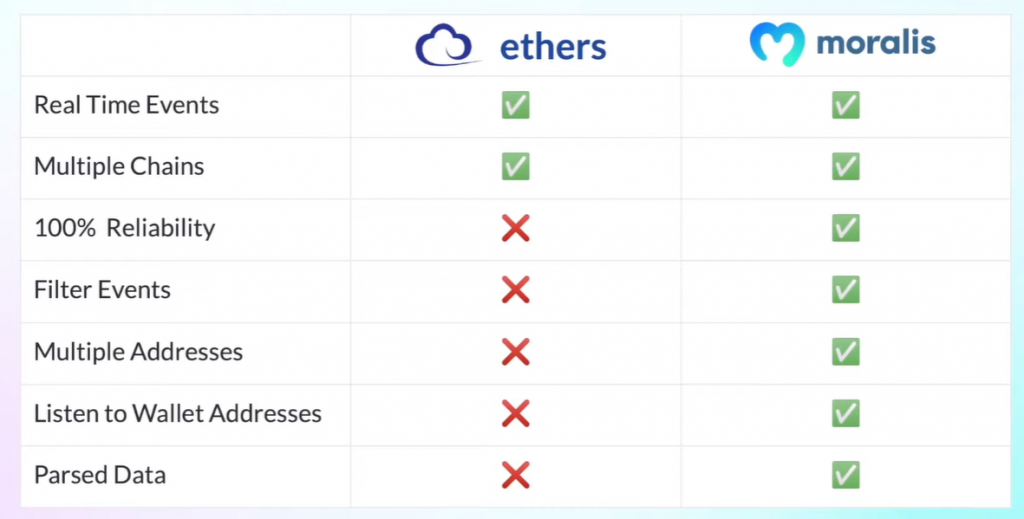
With this fast overview, you’ll be able to immediately see that Moralis supplies every thing ether.js does and extra when establishing blockchain listeners. Nevertheless, simply wanting on the factors made within the desk above may be considerably cryptic. Subsequently, allow us to look at and break down the desk for you within the following sub-section to offer an in-depth evaluation of the variations between ethers.js and the choice the place customers can arrange Web3 streams utilizing the Streams API!
Ethers.js vs Web3 Streams
The desk above exhibits that each ethers.js and Moralis streams assist you to monitor real-time occasions. Each choices assist a number of chains, which means you’ll be able to monitor occasions for various blockchain networks. Nevertheless, whereas that covers the similarities, how do these two choices differ?

First, Moralis gives 100% reliability. However what does this imply? As you may bear in mind from the ”How Can Builders Use Ethers.js Occasions?” part, it is advisable present a separate node supplier when utilizing ethers.js. This may be problematic, as it’s tough to know if the nodes maintained by the supplier will keep operational indefinitely. Nevertheless, this isn’t the case with Moralis, as you’ve gotten a single tech stack and all the time obtain real-time alerts by way of webhooks as an alternative.
You possibly can moreover filter occasions with Moralis’ Web3 Streams API. Consequently, you’ll be able to goal occasions and solely obtain webhooks for the on-chain knowledge you require. You can too pool contracts right into a single stream, which is unattainable when utilizing ethers.js. With ethers.js, you’ll as an alternative have to arrange separate blockchain listeners for brand spanking new contracts.
Lastly, you’ll be able to hearken to pockets addresses when utilizing Moralis. This implies you’ll be able to obtain webhooks every time a pockets performs a selected motion. Furthermore, together with the aforementioned advantages, the info obtained from Moralis webhooks is parsed. As such, you do not want to fret about extra formatting and processing. This additional implies that the info is able to use ”straight out of the field” in your Web3 initiatives.
Nonetheless, try our article on ethers.js vs Web3 streams for extra details about the variations. You may also wish to watch the video down under, displaying you tips on how to arrange blockchain listeners utilizing each ethers.js and Moralis’ Web3 Streams API:
Ethers.js Occasions – Abstract
When you’ve got adopted alongside this far, you now know tips on how to hearken to good contract occasions with ethers.js. On this tutorial, we taught you tips on how to create a blockchain listener for monitoring the switch occasion of the USDC good contract. In doing so, the article confirmed you tips on how to arrange a NodeJS venture, add the code for the blockchain listener, and run the script. Now you can use the identical elementary ideas to watch any good contract occasions utilizing ethers.js on your future blockchain initiatives!
When you discovered this ethers.js instance tutorial useful, think about testing extra Moralis content material. As an example, learn our article on tips on how to get all transfers of an NFT. In that information, you get to discover the accessibility of Moralis’ NFT API, which is likely one of the many Web3 APIs supplied by Moralis. Different outstanding examples are the Token API, Solana API, EVM API, and so forth. Thanks to those instruments, Moralis presents the quickest technique to construct a Web3 app!
Consequently, it doesn’t matter what Web3 improvement endeavors you embark on, enroll with Moralis, as that is how one can absolutely leverage the facility of blockchain expertise!
[ad_2]
Source link
